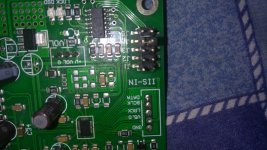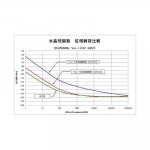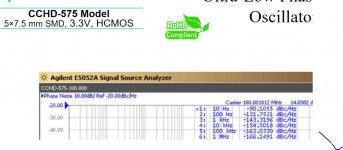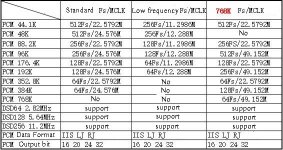...Last test with Hugo tt2 and upscaler convinced me even more what i hear...
If you have that, why do you need Sabre and or AKM?
If you have that, why do you need Sabre and or AKM?
It was misunderstanding. I don*t have them... i listened to them for 1 or 2 days... and was not impressed. My mind was strugling with strange artefacts from time to time. Last half of second a day we disconneted upscaler and sound was more right. With upscaler you got feeling that sound is cleaner, little more dynamic but simple. And after comparing it to already mentioned reference dac, we immediately discovered that a lot of atmosfere, behind tones, fluidity is gone. Hugo is quite analog sounded dac but sound is little blown up like to spiced food where you can*t taste all ingredients. But some people like that.
I have my refference sound in my mind and i look into that direction when i do things.
That combination with different speakers could be heard in a few days at Munich Hifideluxe.
I aplogize for offtopic and maybe starnge explanations.
Btw Mark, what kind of speakers and amplifier and cables do you use for testing?
Thank you D.
...what kind of speakers and amplifier and cables do you use for testing?
My power amp is a Benchmark AHB2 (ultra-low distortion). Speakers are Yamaha NS-10M, with stereo sealed sub-woofers. All speakers are on Primacoustic Recoil Stabilizers (which really help tighten up the imaging and bass). Speaker wires are short length 12-gauge stranded zip cord. Line level input to power amp is usually balanced, although there are trade-offs doing that. Distortion is a bit higher due to the additional circuitry, but it helps with any ground issues as compared to using SE interconnects.
Also, recently acquired a standalone headphone amp, a Neurochrome HP-1 (similar to the HPA in DAC-3, but HP-1 is somewhat lower distortion). The HP-1 is used with my old Sennheiser HD-600 headphones (used to be common for mastering, but now pretty dated). After trying loaner Audeze LCD-4 headphones, now thinking its probably time to replace HD-600 since the technology has improved quite a bit over the years. However, LCD-4 is too expensive to consider.
Another significant part of the system is a used Monster HTPS 7000 MKII power conditioner (designed and recommended by our own Richard Marsh and Demian Martin, the best thing Monster ever sold, IMHO). For those who could afford the investment, sometimes used ones can be found on ebay.
I've soldered together the AVCC filter and regulator as found in the ESS Application Note using a 5532. What sort of benefit would I get using two separate single opamps and also replacing this 5532 with a LM4562 or better?
I'm now using LM317/337 (+/- 15v) feeding a Dexa NewClass D 5V which in turn feeds an Alexey LT3045 and then the opamp filter/reg....is this overkill? Can you have too much regulation.
Next up, I'll start to put together the I/V buffer, I'm going to try the reference differential output.
I'm now using LM317/337 (+/- 15v) feeding a Dexa NewClass D 5V which in turn feeds an Alexey LT3045 and then the opamp filter/reg....is this overkill? Can you have too much regulation.
Next up, I'll start to put together the I/V buffer, I'm going to try the reference differential output.
I've soldered together the AVCC filter and regulator as found in the ESS Application Note...
LM4562 should be better than 5532. OPA1612 is better yet, and is also recommend for output stage building. I run my AVCC opamp from the same +-15v power that I use for the output stage, although some people prefer to attach the negative AVCC opamp rail to ground.
I'm now using LM317/337 (+/- 15v) feeding a Dexa NewClass D 5V which in turn feeds an Alexey LT3045 and then the opamp filter/reg....is this overkill?
There is a need for multiple 3.3v regulators. I run all the 3.3v regulators for my dac from a 5v power supply. If you want to derive your +5v supply from your +15v supply that works, but it is inefficient and will dissipate some heat in your 5v regulator.
Also, an LT3045 can be used as a voltage reference for the AVCC opamp supply. To keep that particular reference voltage really clean, it should not be used to power any additional circuitry.
Other places to use 3.3v regulators are for VCCA, DVCC, and the Clock.
Next up, I'll start to put together the I/V buffer, I'm going to try the reference differential output.
We have recommended AVCC and output stage circuits that are probably a little better than is what in the old ESS app note. MrSlim published them in post #3003 of this thread. Also, an output stage construction project with a slightly more updated output stage schematic can be found at: Dropbox - Output Stage Instructions.zip
In addition to the mods described above, a clock upgrade, and some attention to +-15v power rail source impedances as seen by the opamps, can both help further improve sound quality.
Using gold (flashed or plated) pin headers and gold cable connectors for I2S signals coming into the dac board has been found to audibly reduce jitter. For some other types of signals gold may not be the most preferred choice.
After all the above, probably that would complete most of the dac board hardware upgrades. Firmware would be the next thing that could use some changing, and after that we get into some more recent discussion about clock divider mods for AK4137.
Last edited:
NDK Clock mod
Hi Mark & Others,
Regarding the NDK NZ2520SDA clocks, My friend got a 49.152mhz for $11 including shipping from diyinhk. It fits in the v1.07 green board where they made pads for a smaller size clock within the larger pad. We managed to replace it. Nearly made an error when we tried to solder it with iron and got the solder to short the connections through the top metal case. heat up occurs, fortunately realise it before damage. Finally made it to work with heating by hot air gun and letting it sink into the pads. It is really small.
The datasheet seems to suggest a phase noise of around -122dbc at 10hz compared to -90dbc for the one we use i.e. the cchd-575 crystek, although the noise floor is higher at around -158dbc vs -168dbc.
The mod is a definite improvement soundwise from the stock clock, but since his board is still in the process of modding, yet to do avcc & output stage mod plus ak4137, I could not compare it.
Since it is not expensive, I want to try them to see if it improves sq, especially the lower frequencies. There is a choice of the following freqs : 49.152Mhz/45.1584Mhz/24.576Mhz/22.5792Mhz.
Will there a problem using one of those since our clock is 100Mhz? If not, which one would be the ideal choice among these?
Cheers & Regards,
Kay
Hi Mark & Others,
Regarding the NDK NZ2520SDA clocks, My friend got a 49.152mhz for $11 including shipping from diyinhk. It fits in the v1.07 green board where they made pads for a smaller size clock within the larger pad. We managed to replace it. Nearly made an error when we tried to solder it with iron and got the solder to short the connections through the top metal case. heat up occurs, fortunately realise it before damage. Finally made it to work with heating by hot air gun and letting it sink into the pads. It is really small.
The datasheet seems to suggest a phase noise of around -122dbc at 10hz compared to -90dbc for the one we use i.e. the cchd-575 crystek, although the noise floor is higher at around -158dbc vs -168dbc.
The mod is a definite improvement soundwise from the stock clock, but since his board is still in the process of modding, yet to do avcc & output stage mod plus ak4137, I could not compare it.
Since it is not expensive, I want to try them to see if it improves sq, especially the lower frequencies. There is a choice of the following freqs : 49.152Mhz/45.1584Mhz/24.576Mhz/22.5792Mhz.
Will there a problem using one of those since our clock is 100Mhz? If not, which one would be the ideal choice among these?
Cheers & Regards,
Kay
Attachments
Regarding the NDK NZ2520SDA clocks, My friend got a 49.152mhz for $11...
...Will there a problem using one of those since our clock is 100Mhz? If not, which one would be the ideal choice among these?
It depends. If one wants to be able to play the highest sample rates ES9038Q2M can play in asynchronous mode, then 100MHz (or something closer to that) is better. Some people have tried an 80MHz NZ2520SD (no 'A' suffix), and been happy with the sound.
If one wants to do the clock divider mod the same way I did then 100MHz is better.
If doesn't want those things then various possibilities exist.
If one specifically wants to make a synchronous mode dac, then at set of two NZ25520SDA clocks would be one of the two most popular choices. However, some people like the sound of Crystek 957 clocks for that type of dac. There are various other audio clock manufacturers too, of course.
All the above having been said, aside from standard asynchronous mode operation with a single clock, all options would require some dac register programming, at a minimum. Some options might require more extensive mods we haven't talked about much in this thread.
A single 49MHz NZ2520SDA could be used with the dac board we mod here, with the main limitation that some of the highest sample rates couldn't be played (asynchronously).
Regarding some history and claims about NZ2520SDA, here is something I wrote in another thread:
The very best NZ2520SD parts people ever found were around 15dB better than what Crystek claims for 957 parts, but there were also typically some NZ2520SD duds on every reel that were junk. Therefore, each one had to be tested by the user, or by some 3rd party lab, or people could just take their chances. Now that A-suffix parts are binned out, at least you don't get the worst ones (presumably), but the lowest offset frequency NDK is willing to spec on the data sheet is still 1kHz offset. To me, that means you can still get one with higher than average 1/f corner frequency. Of course, not specifying performance means the clocks can sell for less, since it would cost time and money for NDK to fully test each one.
Last edited:
Hi,
just 2 questions about the clock:
1. Which clock with what frequency is installed on the board without a modification?
2. And if i install a new 80Mhz or 100Mhz clock the board is able to run with "normal" PCM or spdif signals?
just 2 questions about the clock:
1. Which clock with what frequency is installed on the board without a modification?
2. And if i install a new 80Mhz or 100Mhz clock the board is able to run with "normal" PCM or spdif signals?
Hi Mark,
Thanks for the write-up. Indeed the NZ2520SDA datasheet do not include performance graph. The one I attached is from diyinhk; I don't know where they get it from.
All things considered, it might not be a better idea to replace the crystek clock. If the supported sample rates follows the one detailed in the description of AK4137 board (attached below), there's various sample rates that cannot be played whichever clock frequency one choses, unless multiple clocks are used.
Regards,
Kay
Thanks for the write-up. Indeed the NZ2520SDA datasheet do not include performance graph. The one I attached is from diyinhk; I don't know where they get it from.
All things considered, it might not be a better idea to replace the crystek clock. If the supported sample rates follows the one detailed in the description of AK4137 board (attached below), there's various sample rates that cannot be played whichever clock frequency one choses, unless multiple clocks are used.
Regards,
Kay
Attachments
All things considered, it might not be a better idea to replace the crystek clock.
That's my feeling. If I discover a reason to change from Crystek I will post here, but so far I seem to have better luck with Crystek.
If the supported sample rates follows the one detailed in the description of AK4137 board (attached below), there's various sample rates that cannot be played whichever clock frequency one choses, unless multiple clocks are used.
Those number are only for what frequencies the AK4137 board can output, not what input it can accept. Doesn't matter for us if using the clock divider since the 22MHz clock gets removed and AK4137 output sample rate is always set to 12.5MHz DSD256.
@Extreme_Boky
Thank you. The 1st document posted today appears to be an announcement or press release, not the data sheet NDK issues today. The document does confirm the lowest guaranteed offset frequency spec is at 1KHz.
Thank you. The 1st document posted today appears to be an announcement or press release, not the data sheet NDK issues today. The document does confirm the lowest guaranteed offset frequency spec is at 1KHz.
Last edited:
something I posted earlier...
Don't know where the text in that originated. Doesn't sound like it was written by NDK.
By the way, I have done some listening comparisons between Crystek 957 and NDK NZ2520SDA. So far, my impression is that I like Crystek better. However, what I have to say about that may change over time, as I plan to do more comprehensive listening tests with various dacs over the next few months.
T+A top dacs seem to be a trustfull "neutral reference" quite across the continents, while using as far as I understand inhouse conversions - perhaps worthwhile listening to if you can Mark, as benchmark... (Chord's Dave, while mostly acclaimed, seem to belong to the a more "marked" sound category, perhaps less neutral?)
Hi Claude,
Perhaps you are referring to T+A SD 3100 HV? Only $35,000 🙂
It would be nice to listen to one, but the odds of one being available for listening comparisons seems rather remote. So far, haven't even been able to listen to a Chord Dave either.
Hard to predict what might happen though. Just have to wait and see, I guess.
Perhaps you are referring to T+A SD 3100 HV? Only $35,000 🙂
It would be nice to listen to one, but the odds of one being available for listening comparisons seems rather remote. So far, haven't even been able to listen to a Chord Dave either.
Hard to predict what might happen though. Just have to wait and see, I guess.
Ahem, no, rather to the more humble (everything being relative, but 12 times less costly) T+A DAC 8 DSD. That one would already do the trick IMHO - that's the one I had in mind, but of course if you climb the ladder up to their flagship, as long as recent units 🙂
Regarding T+A DAC 8 DSD, according to Stereophile it is popular to use the dac with HQplayer in order to upsample and convert PCM to DSD512. In that case, some part of the sound quality can be attributed to the external software, kind of like some of the sound quality of my modded dac#2 can be attributed to AK4137.
Unfortunately for ES9038Q2M mod'ers, HQplayer v4 is appears to be priced at $245. That can seem like a lot to people trying to mod a low cost dac on a budget. All the more reason to figure out how to take best advantage of what AK4137 can do. For $30 or so, one can get pretty good conversion of PCM to DSD256. I keep thinking about how to best do that vs the way I am doing it now. Seems likely that lowering ES9038Q2M clock frequency might simplify synchronous operation with AK4137 quite a bit. For best CD sound quality that might be the best way to go. Means I have to try it, but I don't have a spare dac ready for running tests at the moment. I am trying to get an Iancanada dac tweaked more to my needs in order to do some testing with it, mostly since it would save me from having to mod another Chinese ES9038Q2M board from scratch. Still some issues to resolve, but odds are pretty good it will end up workable for what I want to do.
Unfortunately for ES9038Q2M mod'ers, HQplayer v4 is appears to be priced at $245. That can seem like a lot to people trying to mod a low cost dac on a budget. All the more reason to figure out how to take best advantage of what AK4137 can do. For $30 or so, one can get pretty good conversion of PCM to DSD256. I keep thinking about how to best do that vs the way I am doing it now. Seems likely that lowering ES9038Q2M clock frequency might simplify synchronous operation with AK4137 quite a bit. For best CD sound quality that might be the best way to go. Means I have to try it, but I don't have a spare dac ready for running tests at the moment. I am trying to get an Iancanada dac tweaked more to my needs in order to do some testing with it, mostly since it would save me from having to mod another Chinese ES9038Q2M board from scratch. Still some issues to resolve, but odds are pretty good it will end up workable for what I want to do.
...how much easier it would be if all was AKM chips (AK4137 + AK4499)...
We will probably find out before too long. The AK4499 evaluation board comes with AK4499, AK4137, and AK4118. Presumably, AKM would like evaluation board users to consider a fully AKM solution for their designs. Of course, it takes all three chips to do some of what one Sabre chip can do (receive SPDIF, perform ASRC), but the three AKM chips can do some things Sabre can't, so there's that.
- Home
- Source & Line
- Digital Line Level
- ES9038Q2M Board




